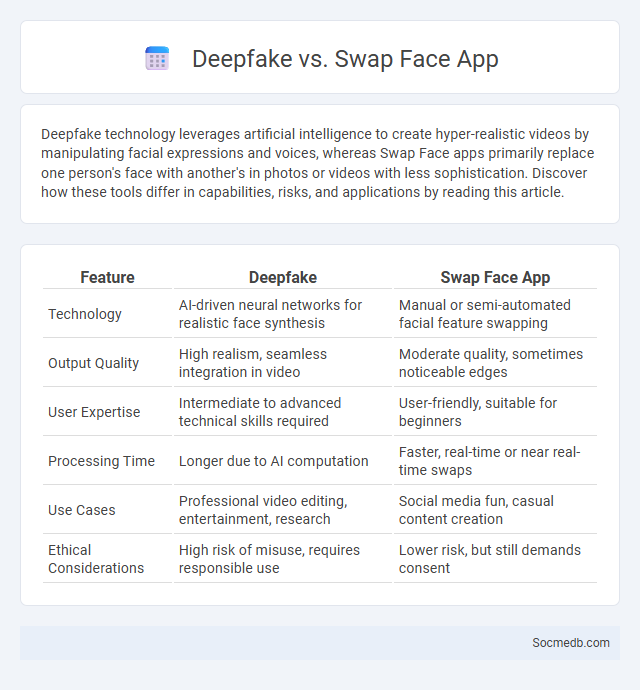
Photo illustration: Deepfake vs Swap Face App
Deepfake technology leverages artificial intelligence to create hyper-realistic videos by manipulating facial expressions and voices, whereas Swap Face apps primarily replace one person's face with another's in photos or videos with less sophistication. Discover how these tools differ in capabilities, risks, and applications by reading this article.
Table of Comparison
| Feature | Deepfake | Swap Face App |
|---|---|---|
| Technology | AI-driven neural networks for realistic face synthesis | Manual or semi-automated facial feature swapping |
| Output Quality | High realism, seamless integration in video | Moderate quality, sometimes noticeable edges |
| User Expertise | Intermediate to advanced technical skills required | User-friendly, suitable for beginners |
| Processing Time | Longer due to AI computation | Faster, real-time or near real-time swaps |
| Use Cases | Professional video editing, entertainment, research | Social media fun, casual content creation |
| Ethical Considerations | High risk of misuse, requires responsible use | Lower risk, but still demands consent |
Introduction to Deepfake and Swap Face Technologies
Deepfake and swap face technologies use artificial intelligence and deep learning algorithms to create hyper-realistic but fabricated videos and images by replacing a person's face with another's in digital content. These techniques utilize generative adversarial networks (GANs) to analyze and replicate facial expressions, movements, and voices, enhancing the authenticity of manipulated media. Their rapid adoption on social media platforms raises significant ethical concerns regarding misinformation, privacy breaches, and identity theft.
How Deepfake Works: AI-Driven Image and Video Manipulation
Deepfake technology utilizes AI algorithms, specifically generative adversarial networks (GANs), to create hyper-realistic images and videos by swapping faces or altering expressions. These algorithms are trained on extensive datasets to learn facial features and movements, enabling seamless manipulation that can deceive viewers. Such AI-driven tools raise significant concerns regarding misinformation and digital security on social media platforms.
What Is a Swap Face App? Key Features and Uses
A swap face app is a mobile application designed to digitally exchange faces in photos or videos using artificial intelligence and facial recognition technology. Key features include real-time face swapping, high-resolution image processing, customizable filters, and easy sharing options on social media platforms. Popular uses encompass entertainment, creating humorous content, enhancing photo editing, and enabling users to visualize different looks for fun or creative purposes.
Comparing Deepfake and Swap Face App: Core Differences
Deepfake technology utilizes advanced AI algorithms to create highly realistic synthetic videos by manipulating facial expressions and voices, while Swap Face apps are simpler tools that primarily replace faces in photos or videos without sophisticated context-aware edits. Deepfake produces more convincing and dynamic results due to deep learning models analyzing and replicating subtle facial movements, whereas Swap Face apps rely on static image overlays. The distinction lies in the complexity and realism of content generation, with Deepfake offering greater potential for misuse in misinformation compared to the more basic face swapping functionality of Swap Face apps.
Popular Deepfake Tools and Platforms in 2024
Popular deepfake tools and platforms in 2024 include DeepFaceLab, FaceSwap, and Synthesia, which offer advanced AI-powered facial synthesis for creating hyper-realistic videos. These tools leverage generative adversarial networks (GANs) and machine learning algorithms to produce high-quality deepfake content with enhanced accuracy and efficiency. Major social media platforms like TikTok and Instagram are increasingly implementing AI-based detection systems to combat the spread of manipulated media created by these deepfake technologies.
Leading Swap Face Applications: Pros and Cons
Leading swap face applications like Reface, FaceApp, and Snapchat offer advanced AI-driven face-swapping features that enhance your social media creativity and engagement. These apps provide seamless integration, user-friendly interfaces, and a variety of filters but pose privacy concerns due to data collection and potential misuse. Understanding the balance between entertainment value and security risks is crucial for safeguarding your digital identity.
Use Cases: Deepfake vs Swap Face in Entertainment and Media
Deepfake technology enables the creation of hyper-realistic videos by superimposing existing faces onto new footage, revolutionizing special effects and enabling seamless actor replacements in films, while face swap techniques allow real-time or pre-recorded content transformations primarily used in social media filters and entertainment apps. Your content strategy can benefit from leveraging deepfake for immersive storytelling in media production or utilizing face swap for interactive audience engagement and viral marketing campaigns. Both technologies raise ethical considerations, making transparency and consent critical when integrating these tools into entertainment projects.
Ethical Concerns and Risks: Deepfake vs Swap Face App
Deepfake technology and Swap Face apps pose significant ethical concerns involving privacy, consent, and misinformation, as they enable realistic manipulation of images and videos that can deceive viewers. Your digital identity risks unauthorized use leading to reputational damage, potential harassment, and spread of false information that undermines trust in social media platforms. Understanding the differences in complexity and accessibility between deepfakes and face swapping tools is crucial for promoting responsible content sharing and enhancing online security.
Legal Implications and Privacy Issues
Social media platforms pose significant legal implications involving data protection laws such as GDPR and CCPA, demanding stringent compliance from companies to avoid hefty fines. Privacy issues center around unauthorized data collection, user consent, and the potential misuse of personal information, raising concerns over digital surveillance and identity theft. Lawsuits related to defamation, intellectual property rights, and user-generated content further complicate the legal landscape of social media usage.
Future Trends in Face-Swapping and Deepfake Technology
Future trends in face-swapping and deepfake technology will emphasize enhanced realism through AI advancements like GANs (Generative Adversarial Networks) and neural rendering, making synthetic media nearly indistinguishable from authentic footage. Your ability to create and detect sophisticated deepfakes will evolve with improved tools integrating blockchain for verifying digital content authenticity and AI-powered forensics. Privacy and ethical concerns will drive regulatory frameworks, shaping how face-swapping tech is deployed in entertainment, marketing, and misinformation prevention.
 socmedb.com
socmedb.com